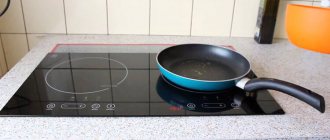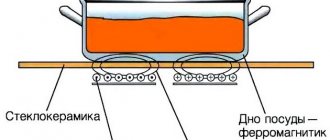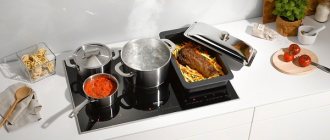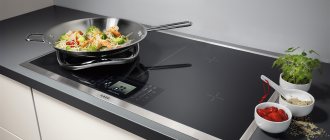It is not enough to purchase modern kitchen appliances for cooking; it is also important to learn the rules of its operation. Many have already appreciated the benefits of induction cookers, and most owners claim that they will not return to old electric cookers, even with a glass-ceramic surface. And some are ready to sacrifice the savings that could be had they installed gas equipment (in homes where this is possible), and give preference to induction cookers. Why is this kitchen appliance so popular among consumers, and how to use an induction hob correctly?
Reasons for the popularity of induction
In comparison with gas and simple electric stoves, this type of equipment has the following advantages.
- Owners of such stoves spend several times less time cooking. Due to the operating principle of an induction cooker, there is no stage of heating the burner, as happens in a conventional electric panel. Copper coils through which alternating current passes create an electromagnetic field, and this, in turn, interacts with the bottom of the cookware, heating it. A liter of water on such a burner will boil in just five minutes. Neither “pancake” hobs, nor even gas ones, can boast of this result.
- Safe cooking. The interaction of induction current occurs only between the coils and the cookware. The burner heats up from the bottom of the pan. As a rule, the panel in this place is slightly warm. And after removing the dishes from the stove, it becomes cold after just a few minutes. Thus, such a stove is safe not only for the direct user, but also for pets that can jump on it. Also, speaking of safety, it is worth noting the possibility of automatically turning it off if there is water on it, or the cooking process takes too long due to the owner’s forgetfulness.
- You can adjust the temperature as accurately as possible - this simplifies the cooking process. Each cooking method (boiling, frying, stewing) has its own mode. As a rule, their decoding is indicated in the device instructions.
- If the cookware is incorrectly selected, the stove will not turn on. This may apply to both the material from which it is made and the diameter of the bottom. Thanks to this property of the device, unwanted repairs of expensive equipment can be avoided.
- Easy care. Due to the low temperature of the panel, food that gets on it does not burn, and accordingly, it does not have to be wiped off the surface. If the induction hob becomes dirty, clean it with a damp cloth. Heavy stains can be easily removed with a silicone cleaner for glass ceramics and a special scraper.
- Rich functionality. The presence of a large selection of programs and child locking will make using the induction hob comfortable.
Is it possible to cook on an induction cooker in regular cookware?
Is it possible to cook on an induction hob using regular cookware? In answer to this question, it should be noted that a lot depends on the coating on the bottom of your cookware. If you look at it objectively, then most likely you will not be able to cook a culinary masterpiece. Because using regular kitchen utensils can cause a number of problems. The induction cooker may not respond to the material your vessel is made of and may remain switched off. Or it may happen that the stove turns on, but no heating occurs, which will leave the vessel cold.
The bottom is the main parameter on which the consumer must focus attention.
This will not cause any harm to the stove itself and will not damage it. The only downside is that you will waste your energy trying to cook something. Therefore, when using such modern technology, it is worth taking care of the appropriate devices.
Many people wonder – what is an induction pan? The answer is the simplest. This is a vessel that has the same dimensions as a regular saucepan. Its difference is a special bottom, which allows it to heat up completely.
The diameter of the bottom must be at least 12 centimeters.
If you simply do not have the funds to purchase special utensils suitable for this technology, then manufacturers have made sure that cooking can be carried out using conventional appliances. This requires the use of magnetic adapters, which are a disk with a handle. It is placed on the burner, after which your dishes are placed on top.
This device will allow you not to change all the dishes, but to safely use the old ones without spending effort and money. This device does not cause any particular harm, but rather quite the opposite. This will protect your stove from unwanted and unfavorable scratches and all kinds of damage.
Connecting an induction cooker
Connecting an induction cooker requires certain knowledge and skills in electrical engineering. The choice of location for installing the device is dictated by the following requirements:
- installation of the slab is carried out on a flat floor/surface without distortions;
- ventilation is provided, small gaps are provided - the device should not overheat;
- the stove must be grounded;
- For connection, a cable with a cross-section of 2.5mm² is used;
- The section of wiring leading to the device must be copper;
- presence of an outlet close to the place of planned installation of the device;
- household wiring must match the load level created by the operating appliance.
If the device is not equipped with a power cable, then you should purchase a power cord yourself, based on the characteristics of the device specified in the documentation. It would be a good idea to consult with a specialist.
Cable for connecting the induction panel
Attention! Mistakes when installing an induction cooker yourself can lead to damage and loss of warranty service for the device, as well as problems with household wiring.
If you are not confident in your abilities, it is better to contact a professional specialist about connecting an induction cooker.
Switching on and off order
An important aspect in operating an induction panel is the correct switching on and off of the device. Most modern models are equipped with a control panel. Activating the operation of such induction cookers consists of the following steps.
- The device is turned on by holding the “On/Off” button for several times.
- The cooker beeps and displays the control menu.
- Using the menu, the user needs to select a burner, set heating parameters and a cooking program.
Turning off the induction cooker at the end of cooking is done using the control panel (item “Shutdown”), if available. A device not equipped with a display can be turned off by pressing the “On/Off” button, which must be held for several seconds until the hob turns off.
Induction cooker malfunctions
The electromagnetic principle of operation of an induction cooker implies high reliability and durability of the device.
POPULAR WITH READERS: Self-repair of an electric kettle, useful tips
Despite this, some breakdowns are possible during operation:
- Low burner power. The likely cause is improper installation of the utensils, which are not located in the center of the work surface. It is possible that the diameter of the pan (pan) is smaller than the diameter of the heated zone. Other reasons include incomplete adherence of the cookware to the surface or overheating of the induction winding;
- The burners on the left side of the stove do not work. The probable cause is a breakdown of the control unit or power board;
- Failure of one of the work areas. Before cooking, it is important to follow a certain sequence of inclusion. First, the burner is selected (using the touch panel), and then the power is set. If everything is done correctly, check the cookware used to ensure it matches the induction cooker (in diameter and material). If the cookware complies with the rules, but the comfort still does not work, activate the temperature sensor test and replace it (if necessary). If the sensor is working properly, make sure that the dishes fit tightly to the surface;
- Two burners on the right side do not work. The cause of the malfunction often lies in poor contact of the terminal box or a blown fuse. It is worth checking the quality of the connection between the control unit and the power board. As a last resort, the unit needs to be replaced;
- The residual heat indicator has failed. Actions - carrying out a test check, the results of which conclude that the temperature sensor is working properly. If the part is in good condition, the control unit is replaced. If the display malfunctions, it is worth checking the quality of the connection between the panel and the control unit;
- The cooking zone does not turn on and there are no messages on the screen. Check the power switch, fuse, and the quality of the connection between the control unit and the power board and touch panel;
- Cooling fan failure. Pay attention to the installed power. If it is minimal, the fan will not work immediately, but after the air temperature reaches 50 degrees Celsius. Do a test run. If the fan fails, replace it. If this unit is in good condition, replace the control unit;
- The induction hob beeps continuously. The probable cause is failure of the control unit;
- The maximum power burner (3 kW) does not work. Switching on the work zone is sometimes blocked to prevent overheating of the induction hob unit. If the problem appears for no reason, the control unit is replaced;
- Automatic switch-off of the hob. The operating principle of an induction cooker is designed in such a way that it switches off in three cases. Firstly, if the time was set by a timer. Secondly, if the burner operates for more than two hours. Thirdly, when after 10 seconds after switching on, no action occurs.
Operating modes
The method for setting the heating power of an induction burner differs between models. It can be:
- touch buttons on the control panel with intuitive symbols “+” and “-”;
- touch digital scale, with the help of which the degree of heating increase is carried out by swiping your finger to the right, and to decrease the power - to the left (slider control);
- mechanical regulators rotate clockwise to increase heating power, and in the opposite direction to reduce heat supply.
In premium-level stoves, the heating power of the burner is adjusted automatically using built-in sensors that determine the size of the cookware.
The number of temperature gradations varies from 3-5 to 10 or more depending on the class and equipment of the device.
Slider power control
To make using an induction cooker more convenient, manufacturers equip the devices with additional functions.
- Booster mode - transfers energy from a free burner to a working one, which allows you to speed up the cooking process.
- Possibility of combining the power of two adjacent burners when using oblong-shaped cookware such as a duck pot.
- Cooking modes for various dishes programmed for specific time and temperature parameters.
- Function of heating dinner left on the stove for a long time.
- Automatic shutdown of the burners - emergency mode is triggered when liquid gets on the working surface.
Some models have built-in cooking modes
Locking and unlocking the surface
A convenient additional option is the ability to block the device from accidentally turning on the oven, changing settings by careless movements or by children. When the lock mode is activated, the device does not respond to pressing the touch buttons on the control panel.
The mode is activated and deactivated by holding the button with the key/lock icon for 3 seconds. A message should appear on the control panel indicating that the lock mode is enabled/disabled. On some models, instead of a message indicating that the lock option is activated, an indicator in the form of a key/lock appears.
To lock the panel use a key in the form of a lock
The procedure for activating and removing protection against accidental clicks may differ for different models. Therefore, it is recommended to carefully study the operating instructions for your specific induction cooker.
All the nuances of surface cleaning
Manufacturers warn that along with the purchase of a hob, you should purchase a special scraper and washing gel for cleaning glass ceramics.
The best inexpensive glass ceramic hobs
All this is available for little money at any hardware or household goods store.
Detergents are widely produced by equipment manufacturers themselves . It happens that they have to be purchased separately; it happens that they are included in the kit for the stove and are initially included in the price of the product. for sale at an average price of 150 rubles for a volume of 500 ml .
I’ll say right away that you shouldn’t skimp on cleaning glass ceramics with special products and look for all kinds of homemade recipes. Firstly, they will last for a long time, since they are very economical in consumption. Secondly, they make it much easier to maintain the surface in perfect condition. Simply rub the gel with a clean cloth and remove with a damp towel. At the end, the panel is wiped dry. Thirdly, a thin silicone film is formed on the stove, preventing the retention of food and fat. This simplifies subsequent cleaning and protects against damage.
Pay attention to the type of scraper. The cheapest ones are made of plastic. They cost about 100 rubles, but are short-lived. It is advisable to purchase a more reliable steel scraper with replaceable blades (the set includes 10 pieces) . This solution will cost more – from 300 rubles, but will last much longer than plastic. Of course, you can find “premium” scrapers for 3-4 thousand rubles, but this is an outright whim. There is nothing to pay for there except for the brand.
Cleaning the hob - do it right
A whole staff of specialists from kitchen appliance manufacturers has developed optimal principles for cleaning glass-ceramic hobs.
They boil down to the following:
- Large food residues are removed with a scraper. When the panel has cooled, the cleaning gel is immediately distributed. The product is spread with a paper towel. Continue cleaning with a damp cloth. At the end, care is completed by wiping the slab dry;
- If any fusible materials (plastic, foil, sugar) get on the surface, they are removed immediately, while hot, using a scraper. Further cleaning follows general principles. When the panel has cooled down, it should be heated again before removing burnt particles;
- around the burners can be cleaned with ordinary soapy water, distributing it with a clean soft cloth;
- stains with a metallic sheen that cause discoloration of the surface, splashes of grease, water, and traces of lime can be removed with cleaning agents for stainless steel or ceramics. They only work on cooled panels. Next, the remaining product is washed off with enough water. Lime is easily removed with vinegar;
- To remove light stains, it is permissible to use glass and mirror surface cleaners;
- Simple splashes of water can simply be removed with a damp cloth.
What you should absolutely not do
Avoid using sponges to wash dishes . This will leave particles of detergents and grease on the hob. The first time you cook food, they will cause the panel to discolor. Standard dishwashing gels can leave stains on glass ceramics. They are almost impossible to remove even with professional cleaners.
Manufacturers do not recommend using special stain removers and oven sprays. In addition, care should be taken to ensure that grains of sand and abrasive particles do not fall on the surface. They cause serious damage. The burners themselves must be dry. Leaving wet marks from pans can damage the burners.
In addition, glass ceramics do not like the following:
- plastic, aluminum, sugar;
- iron brushes, knives, washcloths;
- abrasive powders;
- targeted strikes;
- hot burners are afraid of cold water;
- dirty, greasy napkins.
In general, you can give preference to skin care products from brands of the same name as the panel; you can look for a cheaper product from a neutral manufacturer. The Menalux cleaner with silicone, the top-end Electrolux Toppens, and Domal Glaskeramik have received good reviews.
Dish questions
Don’t be lazy to read the instructions, which indicate the correct type of cookware for the hob and its correct placement on the burners.
Tips for choosing cookware for different types of stoves
It would be a good idea to select pots and pans with the appropriate diameter for the burners . This is no less important part of the successful operation of kitchen appliances than cleaning and connection.
Take a few tips into account:
- copper and aluminum can form pearlescent spots on the panel. Most often they cannot be removed;
- When choosing, pay attention to the bottom of the product. It should be smooth and thick, without scratches, damage, deformation and burrs;
- do not leave empty enamel cookware on a hot stove, this will cause stains;
- Steel, enameled pans with ferromagnetic elements are intended for induction. Brass, glass, copper, porcelain are not suitable;
- Some manufacturers recommend using pans with slightly deformed bottoms. At room temperature it is slightly concave. When heated, it loses its deformation and comes into contact with the panel over its entire area. This ensures heating with less heat loss.
Simply put, all types of cookware have markings indicating which hobs they are intended for. Remember to place the item on the burner first, and only then turn on the panel.
A few words about folk remedies
The ingenuity of housewives has given rise to several creative approaches to cleaning cooking surfaces. For example, on forums you can find advice that it is good to walk on ceramics with a little moistened soda or vegetable oil. Some people suggest replacing the scraper with a razor blade.
I would be careful about following these recommendations. Firstly, soda is an abrasive, and for ceramics it is evil . Secondly, vegetable oil, which supposedly forms a protective film, will burn when the burners heat up and lead to unnecessary headaches. Using a blade to remove stubborn stains is completely dangerous. In general, the rule here is that the stingy pays twice.
Choosing cookware for an induction cooker
There are special requirements for cookware for induction cookers. As with any electric stove, the cookware must have a thickened bottom of at least 2-6 mm or, in the case of frying pans, a solid anti-deformation disk - this will help avoid deformation during high heat. In addition, the diameter of the bottom should not be less than 12 cm. You can use the Turk on an induction cooker only with the help of a special adapter.
The bottom should be flat so that it fits as tightly as possible to the surface. Do not use pots or pans with concave or damaged bottoms. It is also better to discard cookware that was previously used on gas stoves.
The dishes must be made of ferromagnetic material - this is what will allow it to react with copper coils.
A special icon will help you check whether the cookware is suitable for cooking on an induction hob - a pictogram in the form of rounded zigzags or the inscription “induktion” on the bottom of the pan.
This is what the cookware designation for an induction cooker looks like
If there are no signs, you can check the suitability of the dishes using a regular magnet . If the bottom attracts it, then the cookware is suitable for induction. Suitable options include stainless steel, enameled and cast iron cookware.
How to choose suitable cookware for induction cookers
Selecting suitable cookware should be based on the specialized operating principle of the induction panel. The bottom is the main parameter that the consumer must focus on.
The bottom is the main parameter on which the consumer must focus attention.
But, in addition to the bottom, there are several other factors that play a role when choosing a special container. The diameter of the bottom must be at least 12 centimeters. This is necessary so that the vessel heats evenly and the food is cooked efficiently. Of course, we should not forget about the sustainability of the production material. Kitchen utensils should not be subject to even the slightest deformation.
Safety regulations
Induction stoves are considered less dangerous compared to gas and conventional electric stoves. The magnetic field created by a working stove is harmless to healthy people if exposed to it for no more than 3 hours. The surface of the device does not heat up, so you can place food in a free place next to a boiling pan.
The surface of the device does not heat up
However, an induction cooker, like any electrical appliance, requires compliance with operating rules in order to avoid injury and breakdown.
- Remove the dishes with care, avoiding touching the heating zone to avoid burns, since the heat does not dissipate immediately. For the same reason, it is not recommended to leave the dishes on the burner turned on unattended, since if the contents completely evaporate, the pan will overheat and you can get burned. It takes a short time for the glass ceramic surface to cool down.
- It is necessary to use special cookware that matches the diameter of the burner. Do not use pots with deformed bottoms.
- Do not allow moisture to get on the working surface of the stove.
- The surface of the device can only be cleaned after disconnecting from the power supply.
- It is contraindicated for people with pacemakers to be near a working induction cooker.
- Follow standard safety precautions when working with electrical equipment.
Important! It is not recommended to use electronic devices near a running induction cooker due to possible interference.
Rules for caring for an induction hob
As a rule, the surface of an induction cooker is made of durable glass-ceramic material; it requires some maintenance.
- To clean such a surface, it is best to use a separate soft sponge.
- For severe stains, purchase a special scraper for glass ceramics, but not a metal scourer.
- As a detergent, choose silicone-based solutions special for such surfaces, which create a protective film. In extreme cases, you can use liquid dishwashing detergent, but avoid using powder detergents.
- After washing the surface, wipe it dry with a soft cloth.
- If necessary, it is best to wash the hob immediately after cooking.
- Do not allow sugar and salt to come into contact with the glass-ceramic surface. If such granular substances get in, you should brush them off and wipe the surface.










